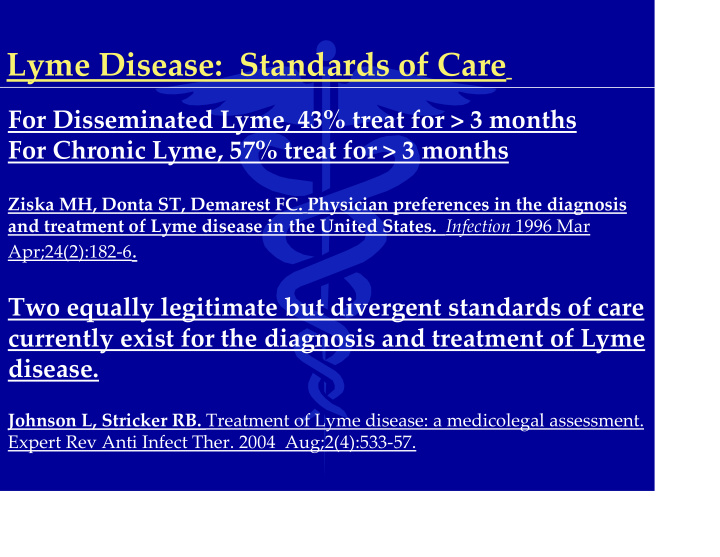



Lyme Disease: Standards of Care For Disseminated Lyme, 43% treat for > 3 months For Chronic Lyme, 57% treat for > 3 months Ziska MH, Donta ST, Demarest FC. Physician preferences in the diagnosis and treatment of Lyme disease in the United States. Infection 1996 Mar Apr;24(2):182-6 . Two equally legitimate but divergent standards of care currently exist for the diagnosis and treatment of Lyme disease. Johnson L, Stricker RB. Treatment of Lyme disease: a medicolegal assessment. Expert Rev Anti Infect Ther. 2004 Aug;2(4):533-57.
In Favor of Antibiotics for Chronic Lyme ILADS Guidelines “Refractory Lyme disease is a devastating condition that usually affects patients with persistent symptomatology and long-term disability. Prompt and aggressive institution of antibiotic therapy may be essential to prevent refractory disease. Increasing evidence shows that antibiotics have a beneficial effect on the course of refractory Lyme disease even in cases where the patient is intolerant of antibiotics or when a previous regimen has failed. Several months of therapy are often required to produce clear evidence of improvement.”
Against Antibiotics for Chronic Lyme ��������������� ξ “To date, there is no convincing biologic evidence for the existence of symptomatic chronic B. burgdorferi infection among patients after receipt of recommended treatment regimens for Lyme disease. Antibiotic therapy has not proven to be useful and is not recommended for patients with chronic (6 months) subjective symptoms after administration of recommended treatment regimens for Lyme disease (E-I).”
����������������� �� ���������������������������� ���������������������������������������������� “the detection of Osp A DNA in joint fluid indicates the presence of viable spirochetes” �������� ������������������ ������������������������ �� ������������������������� ����������������� ! �" �#�����������������������������$���%&� +���������"��(+ ! �������������'����(�)��*� �� ,�����'������������������������������'-. (������������(� ! None of the above discussed in The Guidelines ξ Nocton J J; Dressler F; Rutledge B J; Rys P N; Persing D H; Steere A C. Detection of Borrelia burgdorferi DNA by polymerase chain reaction in synovial fluid from patients with Lyme arthritis N. Engl. J. Med. 1994 Jan, 330:4, 229-34.
����������������� �� ���������������������������� ���������������������������������������������� ξ 38 treated Lyme patients—Long term outcomes ξ 26% relapsed by 1 year and required re-treatment ξ 34% had long term morbidity despite treatment ξ Patient #12 treated with 2 weeks IV penicillin ξ Despite treatment, severe neurologic illness ξ Re-treated--2 weeks IV ceftriaxone without effect ξ She died. On autopsy, brain tissue: Spirochetes demonstrated with mononuclear inflammation ξ None of the above discussed in The Guidelines ξ American patients, therefore sensu stricto ξ Shadick NA, Phillips CB, Logigian EL, Steere AC , Kaplan RF, Berardi VP, Duray PH, Larson MG, Wright EA, Ginsburg KS, Katz JN, Liang MH. The long-term clinical outcomes of Lyme disease. A population-based retrospective cohort study. Ann Intern Med. 1994 Oct 15;121(8):560- 7.
������������������������������������� �� � ��������������� �������������������������� ξ 12 Lyme patients failed antibiotics ξ Spirochetes in synovium: 6 of 12 patients (50%) ξ “…the antigenic stimulus in Lyme arthritis would appear to be a small number of live spirochetes, demonstrated here by monoclonal antibodies, which may persist in the synovial lesion for years.” ξ Steere AC, Duray PH, Butcher EC. Spirochetal antigens and lymphoid cell surface markers in Lyme synovitis. Comparison with rheumatoid synovium and tonsillar lymphoid tissue. Arthritis Rheum. 1988 Apr;31(4):487-95. ξ 67 yr old woman died—ARDS attributed to Lyme ξ Failed 2 weeks tetracycline, 10 days IV penicillin, & a 2 nd course IV penicillin, duration unspecified ξ Autopsy: Lymph nodes—Spirochetes consistent with Bb ξ Kirsch M, Ruben FL, Steere AC, Duray PH, Norden CW, Winkelstein A. Fatal adult respiratory distress syndrome in a patient with Lyme disease. JAMA 1988 May 13; 259(18): 2737-9.
������������������������������������� �� � ��������������� �������������������������� ξ 24 year old woman—EM after camping in PA ξ Years later—arthritis, needed several surgeries ξ Ultimately, seropositive Lyme arthritis diagnosed ξ 2 courses IV penicillin, 3 of IV ceftriaxone, & 1 of IM penicillin all resulted in “dramatic reduction” of arthritis, but relapses after discontinuation of each ξ Doxycycline for 13 months, sulfasalazine for 1 year, & arthroscopic synovectomy did not help ξ Despite multiple antibiotic treatments, synovial tissue & synovial fluid silver stain revealed copious spirochetes; synovial fluid Lyme PCR positive ξ Battafarano DF, Combs JA, Enzenauer RJ, Fitzpatrick JE. Chronic septic arthritis caused by Borrelia burgdorferi. Clin Orthop 1993 Dec(297): 238-41.
������������������������������������� �� � ��������������� �������������������������� ξ 7 Lyme patients with neurologic & urologic findings ξ All treated with ceftriaxone, 3 wk mean ξ 4 of 7 patients (57%) relapsed despite treatment ξ Relapsers re-treated with ceftriaxone for 2-3 wks ξ Antibiotics helpful in all, but 5 of 7 patients (71%) remained symptomatic ξ Patient #2, despite 3 weeks ceftriaxone: Relapsed— Bb demonstrated in bladder biopsy, confirmed with monoclonal antibodies ξ Chancellor MB, McGinnis DE, Shenot PJ, Kiilholma P, Hirsch IH. Urinary dysfunction in Lyme disease. J Urol. 1993 Jan;149(1):26-30.
������������������������������������� �� � ��������������� �������������������������� ξ 58 year old woman, no history of tick bite or EM; neurologic manifestations ξ Seronegative, CSF Lyme antibody negative ξ CSF intermittently positive for Bb immune complexes, Osp A free antigen, and PCR ξ 3 out of 7 LP’s, (43%) were negative by CSF PCR Patient treated anyway and improved from treatment ξ 7 rounds of IV antibiotics & 3 years continuous oral ξ Severe Herxheimer reactions upon re-initiation of each antibiotic therapy, followed by improvements ξ Lawrence C, Lipton RB, Lowy FD, Coyle PK. Seronegative chronic relapsing neuroborreliosis. Eur. Neurol. 1995;35(2):113-7.
������������������������������������� �� � ��������������� �������������������������� ξ 3 CNS Lyme patients—brain biopsy proven persistent infection after antibiotics ξ Patient #1 ξ Seronegative, CSF antibody negative, no pleocytosis ξ CSF cultured positive for Bb sensu lato ξ Treated with 3 wks ceftriaxone, partial improvement ξ Treated with 8 months doxy, patient relapsed, Lyme PCR positive in both plasma & bone marrow ξ Ceftriaxone re-started, but patient died. On autopsy, brain tissue was Lyme PCR positive ξ Oksi J, Kalimo H, Marttila RJ, Marjamaki M, Sonninen P, Nikoskelainen J, Viljanen MK. Inflammatory brain changes in Lyme borreliosis. A report on three patients and review of literature. Brain 1996 Dec; 119 ( Pt 6): 2143-54.
Recommend
More recommend